Explore Phitsanulok - Thailand Travel, Asia
Phitsanulok is strategically located in the heart of Thailand, making it a perfect starting point for exploring the northern provinces. Known for its rich tapestry of history and culture, Phitsanulok serves as a gateway to the enchanting northern region of Thailand. Its central position provides easy access to nearby attractions and cultural landmarks, enriching your travel experience in this historically significant area. This province is not just a historical hub, but also a bustling destination with a diverse range of activities for any tourist.
Population: Approximately 870,000 in 2019.
Economy: Phitsanulok's economy is diverse, with agriculture, particularly rice and fruit, playing a key role. Tourism, local crafts, and small industries also contribute significantly to the province's economic landscape.
Landmarks: Famous for the Wat Phra Si Rattana Mahathat, Sgt. Maj. Thawee Folk Museum, and Phu Hin Rong Kla National Park.
Thailand
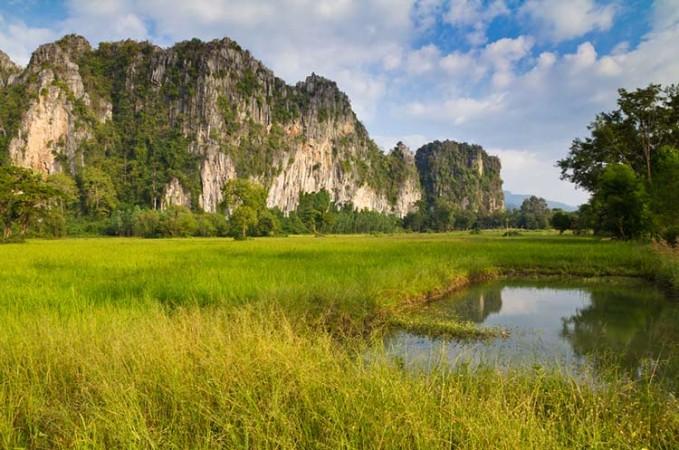
Overview of Phitsanulok
Historical and Cultural Influence
Phitsanulok boasts a fascinating historical backdrop that dates back to ancient times. As one of Thailand’s oldest cities, it was once a prominent center of the Sukhothai Kingdom. Today, it stands as a testament to the region's illustrious past, blending historical sites with vibrant local culture. The province's historical significance is highlighted by landmarks such as Wat Phra Si Rattana Mahathat, where houses the revered Phra Buddha Chinnarat, one of Thailand’s most revered Buddha images. Beyond its temples, Phitsanulok is rich in cultural heritage, showcased through various museums and historical sites, offering a glimpse into the traditional lifestyle of the local people, featuring artifacts and exhibits that narrate the region's history.
Interaction with the Locals
Phitsanulok province, located in northern-central Thailand, has a population of approximately 870,000 residents. The residents of Phitsanulok are well-known for their warm hospitality and rich cultural heritage. The province’s diverse community includes a mix of ethnic Thai locals and various minority groups, contributing to its vibrant cultural tapestry. The citizens are deeply connected to their historical heritage and local customs, which are reflected in their daily lives and community activities.
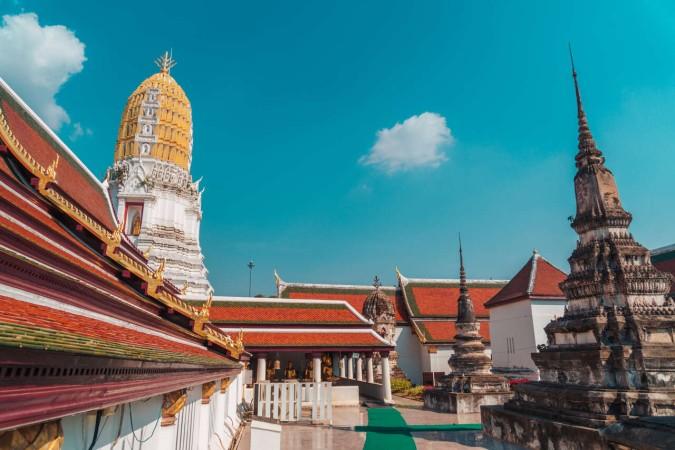
Wat Phra Si Rattana Mahathat - © Thailand Tourism
Top Attractions in Phitsanulok
Must-See Sites in Phitsanulok
- Wat Phra Si Rattana Mahathat: Wat Phra Si Rattana Mahathat is the crown jewel of Phitsanulok. This ancient temple, dating back to the 14th century, is renowned for housing the Phra Buddha Chinnarat, one of Thailand's most revered Buddha images. The temple's stunning architecture, intricate carvings, and serene atmosphere make it a significant cultural and spiritual landmark. A visit here offers a deep dive into the region’s historical and religious heritage.
- Sgt. Maj. Thawee Folk Museum: The Sgt. Maj. Thawee Folk Museum provides a fascinating glimpse into traditional Thai life. This museum showcases a rich collection of artifacts, including traditional clothing, tools, and household items that illustrate the daily lives and customs of the local people. It’s an excellent place for those interested in learning more about the cultural and historical context of Phitsanulok.
Natural Wonders in Phitsanulok
- Phu Hin Rong Kla National Park: For nature lovers, Phu Hin Rong Kla National Park is a must-visit destination. This expansive park is known for its unique geological formations, including striking rock outcrops and scenic viewpoints. It offers a variety of outdoor activities such as hiking, bird watching, and exploring the park’s diverse flora and fauna. The park's cool climate and lush landscapes provide a refreshing escape from the city.
- Kaeng Sopha Waterfall: The Kaeng Sopha Waterfall is a breathtaking natural attraction in Phitsanulok. Located in the Phu Hin Rong Kla area, this multi-tiered waterfall cascades through lush jungle surroundings, creating a picturesque setting ideal for relaxation and picnicking. The sound of the flowing water and the verdant backdrop make it a peaceful retreat for visitors seeking a connection with nature.
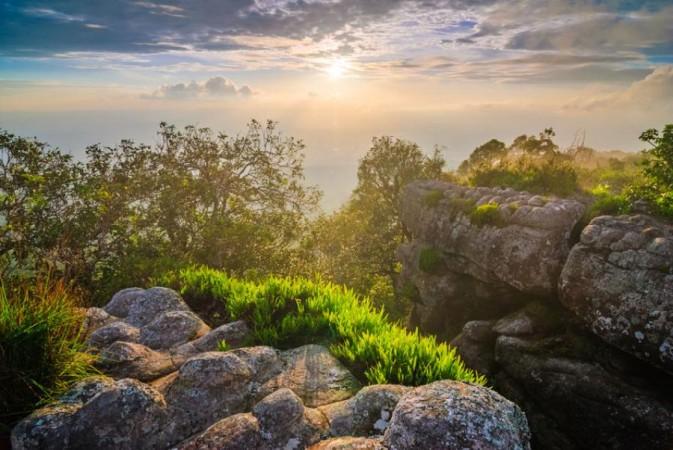
Phu Hin Rong Kla National Park - © Thai National Parks
Must-Try Dishes in Phitsanulok
Phitsanulok offers a delectable array of local dishes that showcase the rich flavors of northern Thai cuisine.
- Kuay Tiew (Phitsanulok Noodles): Phitsanulok noodles, also known as Kuay Tiew Phitsanulok, are a popular local dish. These rice noodles are cooked in a flavorful broth with pork, beef, or chicken, then topped with fresh herbs and crispy garlic. It’s a comforting and flavorful dish you won’t want to miss.
- Kai Yang (Grilled Chicken): Kai Yang, or grilled chicken, is marinated with herbs and spices, then grilled to perfection. It’s typically served with sticky rice and a spicy dipping sauce, offering a satisfying and savory meal.
- Moo Pad Krapow (Pork Skewers): Moo Pad Krapow features seasoned pork skewers, grilled and served with sticky rice and a spicy dipping sauce. It’s a popular street food snack that’s both flavorful and convenient.
- Nam Tok Moo (Spicy Pork Salad): Nam Tok Moo is a spicy pork salad that combines grilled pork, fresh herbs, and a tangy lime dressing. This meal has a bright blend of tastes and is ideal for people who want a little fire.
- Kang Hung Lay (Northern Thai Curry): Kang Hung Lay is a rich and aromatic Northern Thai curry made with tender pork, ginger, and a blend of spices. This substantial curry is frequently served over steaming or sticky rice, creating a soothing and savory experience.
- Khao Niew Mamuang (Thai Sticky Rice with Mango): For dessert, Khao Niew Mamuang is a must-try. This sweet treat combines sticky rice with ripe mango and coconut milk, offering a deliciously refreshing end to your meal.
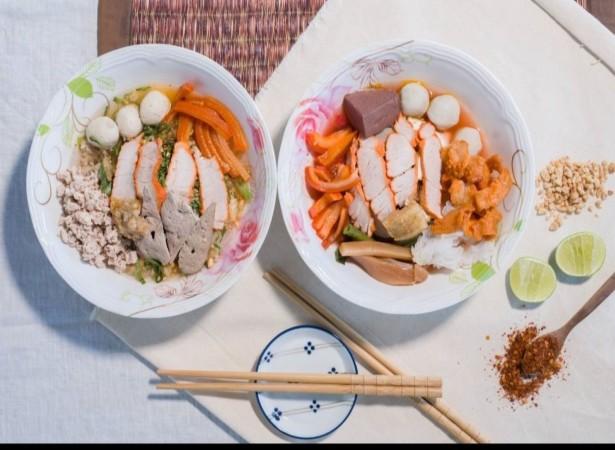
Kuay Tiew (Phitsanulok Noodles) - © Foodpanda
Festivals and Local Celebrations
Phitsanulok's vibrant festivals and local celebrations offer a unique window into the province's cultural traditions and communal spirit.
Phra Buddha Chinnarat Fair
The Phra Buddha Chinnarat Fair celebrates one of Thailand’s most revered Buddha images, the Phra Buddha Chinnarat. Held annually, this fair features religious ceremonies, traditional performances, and cultural exhibitions. Visitors can enjoy the festive atmosphere, browse local crafts, and witness the important rituals that honor this sacred image.
Loi Krathong Festival
The Loi Krathong Festival is celebrated with great enthusiasm in Phitsanulok. During this festival, participants float beautifully decorated krathongs (floats) on rivers and lakes to pay respect to the water spirits. The sight of hundreds of krathongs illuminated against the night sky creates a magical and serene ambiance.
Phra That Phanom Festival
The Phra That Phanom Festival celebrates the revered Phra That Phanom temple, an important spiritual site in Phitsanulok. This festival includes traditional dance performances, religious processions, and cultural exhibitions, drawing both locals and visitors to honor the temple’s significance.
Songkran Festival (Thai New Year)
Songkran, the Thai New Year festival, is celebrated with lively water fights and traditional rituals in Phitsanulok. During this festival, locals and tourists alike engage in playful water battles, visit temples for merit-making, and participate in various cultural events that mark the beginning of the Thai New Year.
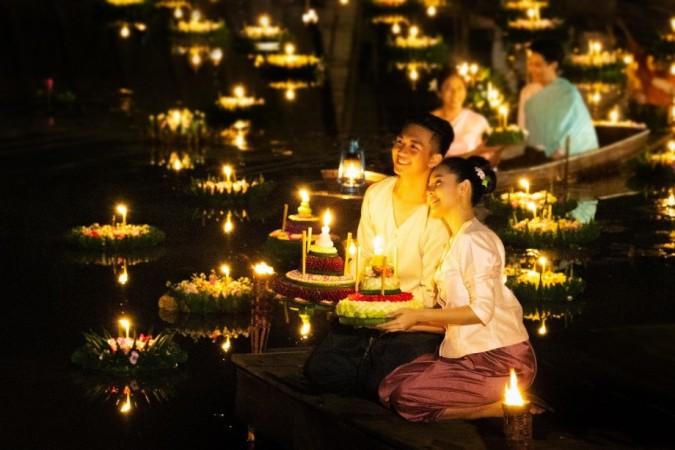
Loi Krathong Festival - © VnExpress
What to Do in Phitsanulok
- Explore Phu Hin Rong Kla National Park: Discover the natural beauty of Phu Hin Rong Kla National Park, a haven for outdoor enthusiasts and nature lovers. Enjoy hiking through lush forests, marvel at unique rock formations, and take in stunning panoramic views from the park’s scenic viewpoints.
- Visit Wat Phra Si Rattana Mahathat: Immerse yourself in the spiritual and historical significance of Wat Phra Si Rattana Mahathat. This ancient temple, known for its beautiful architecture and the revered Phra Buddha Chinnarat statue, offers a glimpse into Thailand’s religious heritage.
- Relax at Kaeng Sopha Waterfall: Enjoy a tranquil escape at Kaeng Sopha Waterfall, an ideal spot for unwinding. This picturesque waterfall, nestled in lush surroundings, is perfect for a relaxing picnic or a refreshing dip in its cool waters.
- Enjoy Local Markets and Shopping: Experience the local shopping scene at the Phitsanulok Night Bazaar. Browse through stalls selling crafts, souvenirs, and delicious street food. The busy environment offers an exciting look into local life and culture.
- Participate in Traditional Festivals: Join in the festivities during local events like the Loi Krathong Festival and Songkran Festival. These celebrations offer a chance to engage with local traditions, enjoy cultural performances, and experience Phitsanulok’s vibrant community spirit.
- Explore Historical Sites: Take a tour of Phitsanulok’s historical landmarks, including Phra That Phanom Temple. Learn about the province’s rich heritage and explore the cultural significance of these important sites.
Shopping in Phitsanulok
- Phitsanulok Night Bazaar: The Phitsanulok Night Bazaar is a vibrant market where you can find a wide range of products, from local handicrafts and souvenirs to street food and clothing. The lively atmosphere and variety of stalls make it a must-visit for an authentic shopping experience.
- Central Plaza Phitsanulok: Central Plaza Phitsanulok is a modern shopping mall offering a mix of international and local brands. With its variety of retail shops, dining options, and entertainment facilities, it’s a convenient spot for a comprehensive shopping experience.
- Phitsanulok Walking Street: Phitsanulok Walking Street is a popular pedestrian market that operates on weekends. It features an array of local products, including traditional crafts, clothing, and food items. The relaxed, open-air setting provides a great opportunity to explore local goods and enjoy the community vibe.
- Local Artisan Shops: Explore local artisan shops scattered around Phitsanulok for unique, handcrafted goods. These boutiques offer traditional Thai arts and crafts, such as handwoven textiles, pottery, and intricate carvings, perfect for souvenirs or gifts.
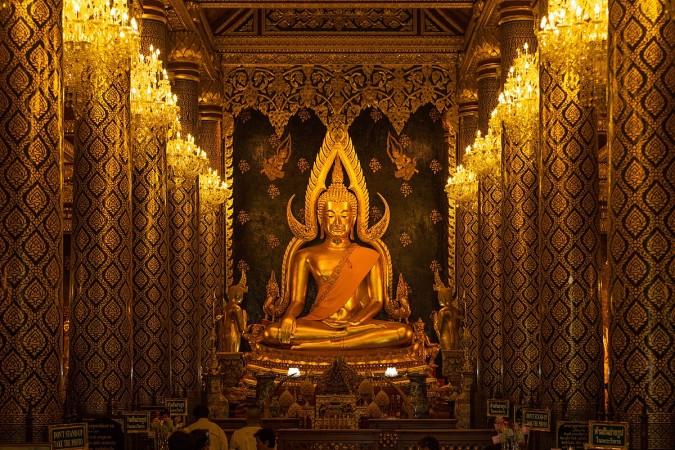
Visit Wat Phra Si Rattana Mahathat - © Wikipedia
Weather in Phitsanulok: Best Time to Visit
Dry Season in Phitsanulok
- Weather: This is the most popular time to visit Phitsanulok. Expect warm temperatures with lower humidity, making it ideal for outdoor activities and exploring the province. Daytime temperatures typically range from 25°C to 35°C (77°F to 95°F), with cooler evenings.
- Tourism Trend: The dry season is the peak tourist period in Phitsanulok. With warm temperatures and lower humidity, it’s the ideal time for outdoor activities and sightseeing. Visitors flock to popular attractions such as Phu Hin Rong Kla National Park and local festivals, enjoying the clear skies and pleasant weather. This is also when cultural festivals, such as the Phra Buddha Chinnarat Fair, are in full swing.
Monsoon Season in Phitsanulok
- Weather: The rainy season brings frequent showers and higher humidity. Temperatures remain warm, averaging between 24°C and 33°C (75°F to 91°F). While the rain can be heavy, it usually comes in short bursts, leaving plenty of opportunities to explore.
- Tourism Trend: During the rainy season, Phitsanulok experiences frequent showers and higher humidity. While this period might deter some tourists, it offers a quieter and more serene experience. The lush green landscapes and dramatic skies make it a great time for photography and appreciating the natural beauty of places like Kaeng Sopha Waterfall. Additionally, this is a good time to enjoy indoor attractions and local markets without the usual crowds.
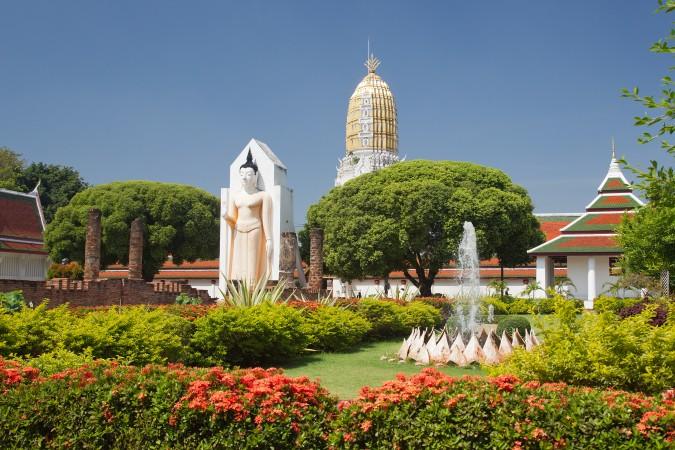
Any day is a good day to visit Phitsanulok - © Wikipedia
Essential Travel Information
Getting Around Phitsanulok
- Buses and Songthaews: Public buses and Songthaews are available for travel within Phitsanulok and to nearby cities. They are affordable and provide convenient options for long-distance travel.
- Tuk-Tuks and Motorbike Taxis: For short distances within the city, tuk-tuks and motorbike taxis are popular choices. They offer a quick and economical way to navigate through traffic.
- Cars: Renting a car is a great option for those who want to explore Phitsanulok and its surroundings at their own pace. Several rental agencies offer vehicles for daily or weekly use.
- Bicycles and Motorbikes: Renting a bicycle or motorbike is another option for exploring the city and nearby attractions. It allows for more flexibility and is ideal for those who enjoy an active way of getting around.
ATM & Banking Services
In Phitsanulok, you'll find a range of convenient banking services and ATMs scattered throughout the city. ATMs are widely available at major shopping centers, tourist spots, and busy streets, providing easy access to cash with international credit and debit cards. For additional banking needs, including currency exchange, numerous branches of local and international banks offer comprehensive services.
Where to Stay in Phitsanulok
- Luxury Hotels: For a premium experience, luxury hotels in Phitsanulok provide top-notch amenities such as swimming pools, spas, and fine dining options. These establishments cater to guests seeking comfort and high-quality services.
- Mid-Range Hotels: Comfortable mid-range hotels offer good value with essential amenities and convenient locations. These hotels are ideal for travelers looking for a balance of comfort and affordability.
- Hostels: For a more social atmosphere, hostels in Phitsanulok offer a friendly environment and opportunities to meet fellow travelers. Hostels are a great choice for those seeking an economical and communal stay.
- Homestays: These accommodations provide a unique opportunity to live with local families, offering insights into Thai culture and daily life. Homestays are an excellent choice for those seeking a more immersive and personal travel experience.
Articles for you

Explore Yala National Park - Sri Lanka Travel, Asia
Tucked away in Sri Lanka’s southeastern corner, Yala National Park is where wild nature meets deep tradition. Known worldwide for its leopard population, the park is also home to elephants, sloth bears, crocodiles, and hundreds of bird species. Beyond wildlife, Yala opens doors to a cultural landscape dotted with ancient temples, Buddhist ruins, and coastal villages. For travelers seeking more than just a safari, Yala offers a chance to explore eco-tourism, local communities, and sacred heritage sites.
Population: The Yala National Park area doesn’t have a human population.
Economy: The economy around Yala National Park thrives on a blend of eco-tourism, agriculture, and local services. Safari tours, eco-lodges, and cultural experiences drive steady income for nearby towns like Tissamaharama and Kataragama, supporting thousands of families.
Landmarks: Famous for Block I of Yala and wildlife encounters, including elephants, sloth bears, crocodiles, and exotic bird species.

Explore Galle - Sri Lanka Travel, Asia
Nestled on Sri Lanka’s southern coastline, Galle is a vibrant city where history meets the sea. Its cobbled streets, colonial architecture, and serene beaches make it a must-visit destination for travelers seeking a blend of culture, adventure, and relaxation. A UNESCO World Heritage site, Galle captivates visitors with its Dutch Fort, bustling markets, and friendly locals. Whether you’re exploring the ramparts at sunset or savoring fresh seafood by the shore, Galle promises an unforgettable journey into Sri Lanka’s heritage.
Population: Approximately 113,000 in 2023.
Economy: Galle’s economy thrives on tourism, trade, and fisheries. The city’s historic fort, colonial architecture, and coastal charm draw thousands of international visitors each year, making tourism its main economic driver. Fishing remains vital for local livelihoods, supplying fresh seafood across the region.
Landmarks: Famous for the Galle Fort, Dutch Reformed Church & Maritime Museum, and Unawatuna Beach.

Explore Bentota - Sri Lanka Travel, Asia
Nestled along Sri Lanka’s southwestern coast, Bentota is a tropical paradise that blends golden beaches, vibrant culture, and thrilling adventures. Famous for its calm waters, luxury resorts, and scenic river estuary, Bentota has become a top destination for travelers seeking both relaxation and authentic experiences. From serene beach walks at sunrise to adrenaline-pumping water sports, this coastal town offers a perfect balance of leisure and exploration. With its proximity to Colombo and Galle, Bentota is easy to reach, making it an ideal stop for both short escapes and extended holidays.
Population: Approximately 37,000 in 2023.
Economy: Bentota’s economy thrives mainly on tourism, which drives local businesses such as hotels, restaurants, and wellness retreats. The town also benefits from fishing, coconut cultivation, and handicrafts like wood carving and batik textiles. Many residents rely on the growing demand for water sports and Ayurvedic treatments, making tourism the backbone of both income and employment in the area.
Landmarks: Famous for Bentota Beach, Bentota River Safari, and Kande Vihara Temple.

Explore Mirissa - Sri Lanka Travel, Asia
Mirissa is a charming coastal town on Sri Lanka’s southern shoreline. Known for its golden beaches, turquoise waters, and vibrant marine life, it has become a must-visit stop for travelers exploring the island. Many come for whale watching, surfing, and sunset views at Coconut Tree Hill, but Mirissa offers much more than postcard beauty. The fishing boats you see anchored by the bay carry generations of stories. Local traditions, delicious cuisine, and a laid-back rhythm of life shape every visitor’s experience.
Population: Approximately 4,700 in 2023.
Economy: Mirissa’s economy is largely shaped by its coastal location. Fishing has long been the backbone of local livelihoods, with generations relying on the Indian Ocean for income. In recent decades, tourism has become the main driver of growth, thanks to whale watching, surfing, and beachside hospitality.
Landmarks: Famous for Mirissa Beach, Coconut Tree Hill, and Parrot Rock Bridge.

Explore Nuwara Eliya - Sri Lanka Travel, Asia
Tucked away in the Central Highlands of Sri Lanka, Nuwara Eliya is often called “Little England”. With its rolling tea plantations, cool misty mornings, and colonial charm, this mountain town feels like a step into another world. Travelers come here to breathe fresh air, walk through flower gardens, sip the finest Ceylon Tea, and enjoy a pace of life far from the island’s busy cities. Whether you’re drawn by scenic landscapes, heritage architecture, or the warmth of its people, Nuwara Eliya is a destination that blends nature, culture, and history in perfect harmony.
Population: Approximately 781,000 in 2023.
Economy: Nuwara Eliya’s economy thrives mainly on tea production, as it sits in the heart of Sri Lanka’s central highlands, famous worldwide for Ceylon Tea. The city also benefits from a growing tourism industry, attracting visitors with its colonial charm, cool climate, and scenic landscapes.
Landmarks: Famous for Gregory Lake, Hakgala Botanical Garden, and Victoria Park.

Explore Sukau - Malaysia Travel, Asia
Nestled on the banks of the Kinabatangan River in Sabah, Malaysian Borneo, Sukau is a destination where wildlife, culture, and conservation come together. Known as one of Asia’s top spots for river safaris and eco-tourism, this quiet village offers a front-row seat to encounters with Bornean orangutans, pygmy elephants, proboscis monkeys, and exotic birdlife.
Population: Approximately 1,400 in 2019.
Economy: Sukau’s economy is shaped by its riverine location and natural resources. Traditionally, the Orang Sungai community relied on fishing, small-scale farming, and forest gathering for their livelihood. Today, the village has shifted toward eco-tourism, with river cruises, jungle trekking, and homestays providing income.
Landmarks: Famous for the Kinabatangan River cruises, Gomantong Caves, and Ox-bow lakes and wetlands.
